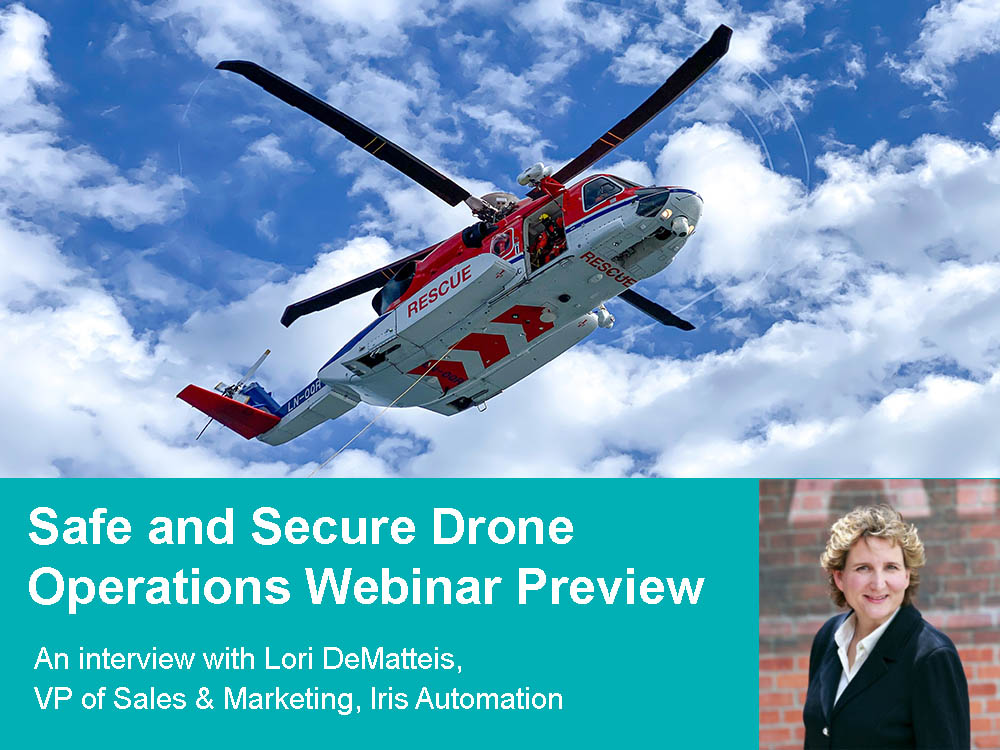Helping drone pilots and program managers expand their operations with Beyond Visual Line of Sight (BVLOS) capabilities has long been a focus for Iris Automation. Such efforts stem from a fundamental endeavor on the company’s part to solve the technical challenges that need to be dealt with in order to reliably, securely, and consistently fly safe drone missions. To get a sense of what that actually looks like, Iris Automation has outlined how detect-and-avoid technology can be used to mitigate the risk of airborne collisions. This has allowed the company to outline a wide range of use cases that showcase how drones can create value for enterprise stakeholders on multiple levels.
These technical innovations can create efficiencies across numerous industries are set to be discussed in detail during an upcoming Commercial UAV News webinar. Experts from across the space will discuss why security and safety matter, what you can do to build a safe drone operation, how to best document your operations and much more.
In preparation for that discussion, we connected with Lori DeMatteis, VP of Sales & Marketing at Iris Automation. She’ll have plenty more to outline as one of the webinar participants, but we wanted to get a better sense of how her experience as a global executive leader factors into her role at Iris Automation - what she sees as the biggest challenges for users and how the future of the airspace will take shape.
Click here to sign up for the webinar.
Jeremiah Karpowicz: What have been some of the biggest lessons learned from your work and experience across multiple industries that you’ve been able to bring to the drone industry?
Lori DeMatteis: Without doubt I learnt long ago working across various industries that they care less about the shiny new technology and a lot more about how you can solve their specific problem. This applies completely to the drone industry.
While there is some excitement about how drones may shape our future, the customers we speak with across a range of industries really want to know how they can practically implement them and how it can positively affect their service levels, costs and operations. In other words, how they can maintain their market leadership, competitive edge and differentiation while driving efficiencies and effectiveness. They don’t want to be one of those companies that are no longer part of the Fortune 30 because they didn’t adapt to change.
How foundational is the work that Iris Automation has placed into safe BVLOS operations when it comes to enabling safe and secure drone operations that will unlock the true value of drone technology at scale?
Very foundational.
Until drone operations can scale, they are limited to a drone with one or more operators or pilots and limited to flying within line of sight. That isn’t viable for large-scale industry deployment. Providing a way for drones to operate safely, with less than one pilot per drone or multiple visual observers, over long distances are the big breakthroughs the market is looking for in widespread deployments.
The good news is that it is here now, and the industry can move forward in exploring new use cases, costs and, in some cases, even lifesaving benefits.
Ultimately, are the biggest challenges you’ve seen when it comes to operating drone missions more about technology, established processes, communication between departments, or something else?
It’s definitely a combination of challenges. We’d say the overarching one is how do you fly drones safely. To achieve that is a combination of technology (detect and avoid technology), regulations that are emerging from national flight regulators across the globe, and organizations having the right team for commercial drone operations.
The general public has also become more accepting of drone technology, particularly since the pandemic. Many have experienced first-hand small package delivery operations, or vital medical drops. Others have directly benefited when we had wildfires last summer in the West.
Iris Automation CEO Jon Damush has talked with us about the inevitable merging of UAM and UAV, but how do you envision that evolution/merging of the airspace will take place on a practical level?
If various manned and unmanned systems need to share the same airspace, we’re going to have to find the safest way for that to happen. That’s why the evolution of regulations is at the center of so much effort at the moment.
Here in the US, we have the FAA’s BEYOND, in Canada the Pathfinder program, and so forth around the world. Regulators are acutely aware that unmanned systems are offering important aviation solutions and business effectiveness and therefore must be safely incorporated into the national airspace.
Is there one thing you want our audience to know about how Iris Automation can help them reliably, securely, and consistently fly safe drone missions, what would it be?
We would like your audience to know that we’ve solving two big challenges for customers – the very complex technology challenge of building detect and avoid solutions, and help with the still emerging regulatory landscape customers must navigate in order to launch a commercial drone program. The two challenges go hand in hand and here at Iris Automation we believe we are further along than anyone in solving them. It’s an exciting time.















Comments